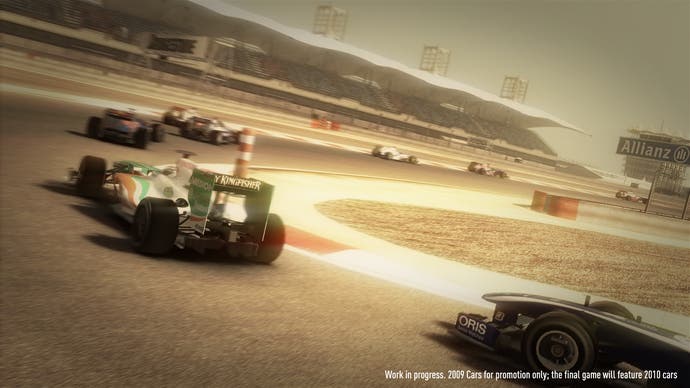F1 2010
Candid camber.
"It's quite awkward that the cars go quite quickly, if you look at GT or Forza most of the popular multiplayer races are in the lower ranks where you've got more time to brake, more time to react and catch the car," says chief game designer Stephen Hood. "F1, it's all over in a flash. But we're trying to make the cars quite consistent, so you're able get into a rhythm. I brake here, this is where I accelerate. Once you get into that rhythm, that's when you start to push it, you're on the throttle a bit earlier coming out of a corner and it starts to step out and you can catch it. We're doing a lot of work on that at the moment, I think that will be ongoing throughout the series, but it's looking promising."
Besides, "a lot of games have focused too much on car handling to the detriment of AI," argues senior producer Paul Jeal, and he might have a point. F1 2010 features the combative, situationally-aware opponents that GRID fans will remember, albeit less crash-happy. Codemasters shows clips of AI drivers making defensive lurches across the track or trying to shake the player off their slipstream. They also have the characteristics of their real-life counterparts, excelling at wet-weather driving, starts, overtaking or tyre management as appropriate.
With refuelling having been banned for the 2010 season, strategy now focuses on managing those tyres - usefully for Codemasters perhaps, since grip has more impact on the moment-to-moment driving experience (although the animators who got as far as motion-capturing a full pit team including fuel rig before the rule change was announced might disagree).

The track surface is fully dynamic in both dry and wet conditions, with the racing line becoming increasingly grippy as a race goes on, but the rubber "marbles" scattered by wearing tyres making the rest of the track more and more hazardous. You can even use wet patches on a drying track to cool your tyres, while the driver has control over wing angles and engine performance levels, as do the current F1 pilots, if they wish.
The number of cars on track is yet to be confirmed due to the instability of the team line-up this season; Codemasters was ready to field a full grid of 26 cars for 13 teams, but only 12 teams made the season's first race in Bahrain last weekend. In online multiplayer the numbers will be halved, with each player taking a whole team's slot, but that's still a healthy grid of 10 to 13 opponents. In both multiplayer and career mode, the game will set you objectives relative to the ability of your car and your standing against your opponents.
"If you're driving for a Lotus or a HRT [in multiplayer] you're not expected to win every race, you have an objective which looks at the relative quality of the car, your times on that track in comparison to the other people in the room, the ranks of the other drivers, and you might be given the objective of trying to finish in the top three, try to finish fifth," says Hood. "So you still have a goal, and it's not about that charge for the first corner."

It's when this objective system slots into the broader canvas of the career mode that things get really interesting. A career game can run for three, five or seven seasons; a shorter run will give you the option of starting in a top team, while over seven seasons, you'll need to start at the back of the grid in one of the sport's three new teams, Lotus, Virgin or HRT. The ultimate aim is obviously to win the championship, but in the early stages it might just be to reach the second round of qualifying or complete a race distance; and you've the choice of trading seats to the top, or bringing your original team with you.
"Some players might choose not to hop team, they might say, 'I love Lotus, they're my favourite team and I want to make them champions.' In this game... they can become a Ferrari, a world-dominating team," says Hood. "You don't feel as though they're just a stepping stone." Although, for licensing reasons, you'll be stuck in a sort of 2010 groundhog year as far as the driver line-ups and liveries are concerned, Hood thinks that the evolving fortunes of the teams, influenced by your own performance, will make them feel different. "Once you've gone past that first season which is very much 2010, then you kind of create your own fantasy," he says.








